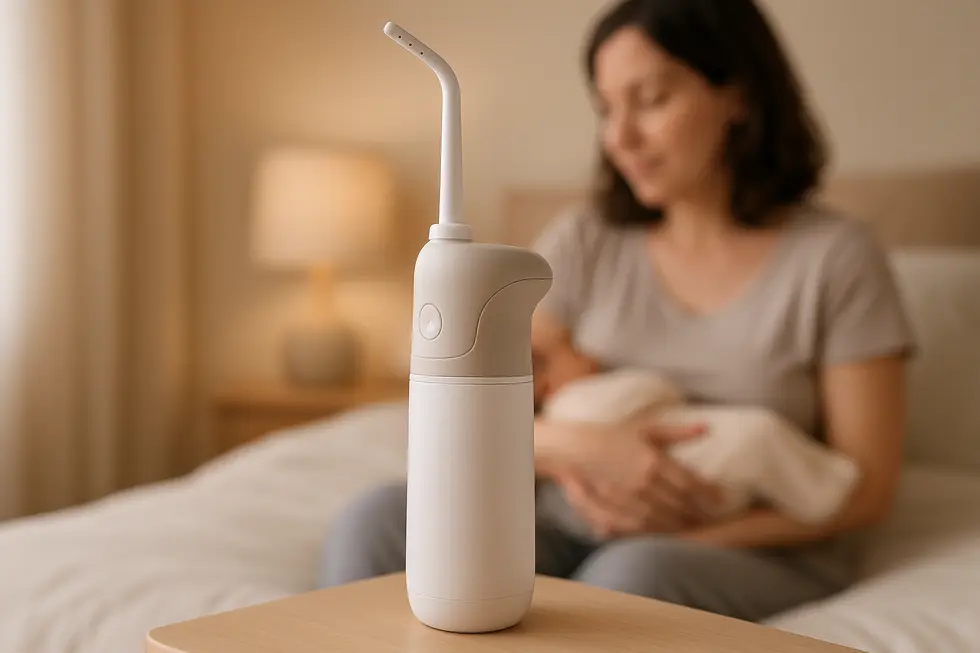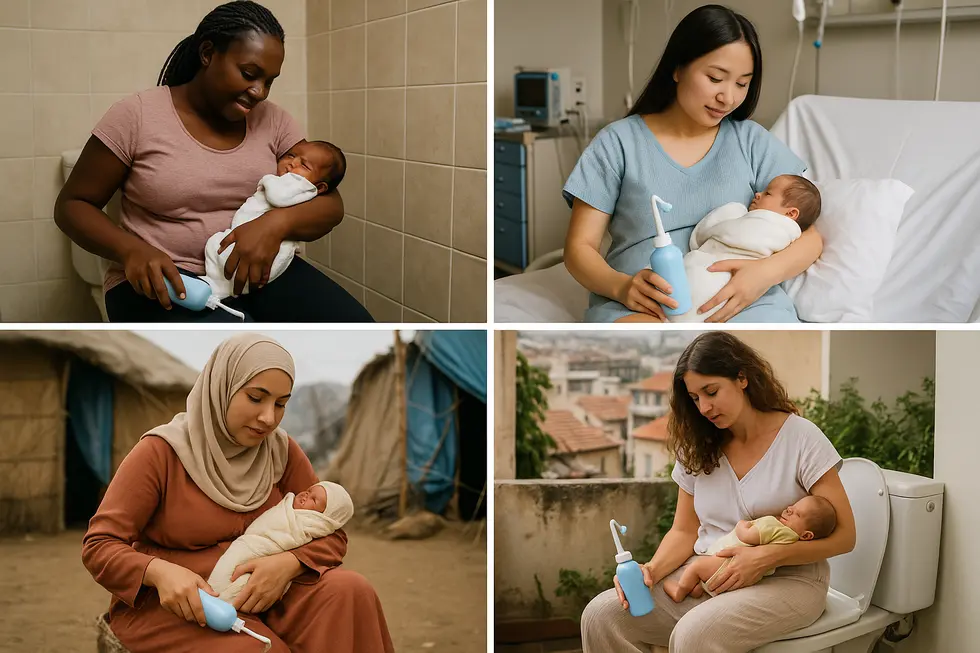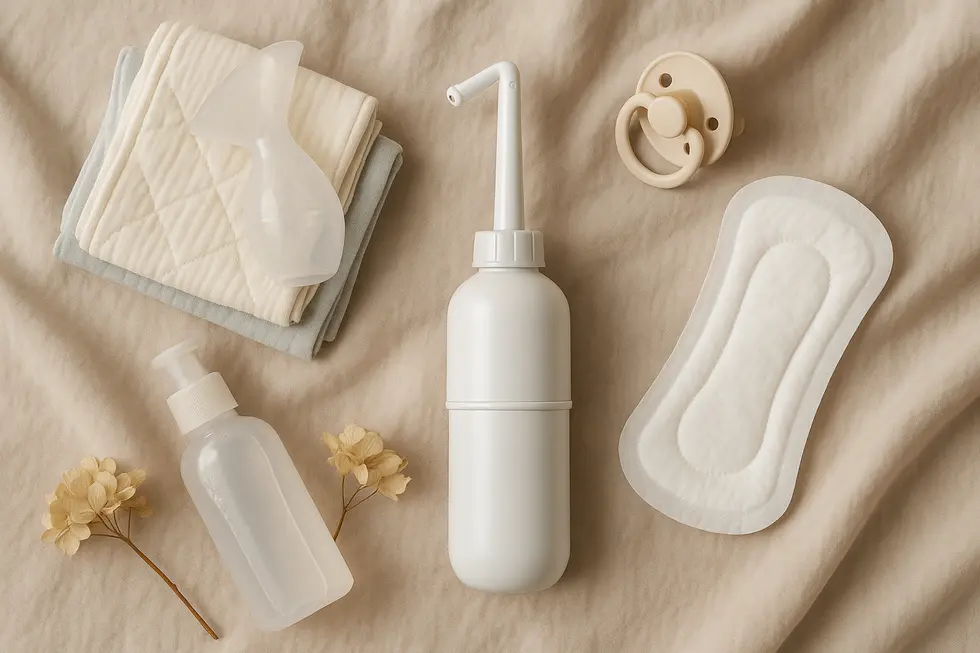Portable Bidet
Postpartum Comfort: Exploring the Role of Portable Bidets in New Mother’s Recovery
Navigating postpartum recovery can be challenging for new mothers, especially when it comes to personal hygiene and comfort. Portable bidets have emerged as a practical solution, offering gentle care for the sensitive perineal area after childbirth. This article delves into the technological innovations, the economic landscape, and the societal and geopolitical dimensions of portable bidet use in postpartum care, providing a holistic understanding of their role in modern maternal health.
Smart, Gentle, and Green: How Tech-Driven Portable Bidets Transform Postpartum Hygiene

Recovery after childbirth leaves skin tender, mobility limited, and routine hygiene suddenly complex. Technological leaps in portable bidets tackle each of those hurdles in a single, palm-sized device. The modern squeeze bottle still anchors the category, but behind its simplicity lies thoughtful engineering: medical-grade polypropylene resists 100 °C sterilisation, angled nozzles rotate 180° so water reaches the perineum without awkward bending, and internal check valves keep back-flow from contaminating the bottle. For parents discharged from hospital with stitches or minor tears, that sterile, low-pressure stream replaces abrasive wiping and helps keep sutures free of residue that can delay healing.
Motor-assisted models build on the same principles while eliminating hand strength as a variable. Rechargeable pumps create a consistent, adjustable spray—light mist for immediate postpartum days, firmer flow once swelling subsides. Some prototypes embed micro-heaters that bring tap water to a comforting 37 °C in seconds; others rely on double-walled reservoirs that preserve warmth for a full bathroom visit. These temperature controls are more than luxury: lukewarm water boosts circulation and washes away lochia without the sting of cold or the risk of scalding.
Designers are also layering in sustainability. Each bidet session prevents several sheets of single-use paper and the hidden litres of fresh water needed to manufacture it. Over a typical four-week recovery, that reduction translates into roughly 1.5 kg of pulp saved—an appealing statistic for eco-minded families and municipal maternity programmes alike. Collapsible reservoirs and USB-C charging further cut plastic waste by encouraging long service life.
Perhaps the most underrated innovation is autonomy. When a new mother can refresh herself without relying on a partner or nurse, she preserves dignity and regains a sense of control that often buffers baby-blues. For practical tips on nozzle angles, safe water temperatures, and hygiene maintenance, see this comprehensive portable bidet guide.
By marrying ergonomic hardware, smart temperature management, and green design, today’s portable bidets replace a once awkward hospital accessory with a thoughtfully engineered recovery tool—one whose benefits continue well after postpartum needs subside. (Learn more about mini portable bidets and postpartum healing.)
From Niche Necessity to Billion-Dollar Boom: The Economics Powering Portable Postpartum Bidets

The humble squeeze bottle once slipped into hospital discharge packs has matured into a driver of a multibillion-dollar market. Analysts peg the global bidet ecosystem at roughly $22 billion in 2024, and portable formats—manual and motorised alike—are grabbing a swelling share as annual growth heads toward 4 percent. Although sales reports seldom isolate postpartum purchases, maternity retailers reveal that new parents now account for a sizeable slice of volume, attracted by gentle cleansing, lower infection risk and the promise of environmentally smarter self-care.
Economic momentum rests on three intertwined forces. First, technology has slashed barriers to entry. Lightweight polypropylene tooling and USB-rechargeable pumps mean newcomers can launch devices for under ten dollars wholesale, while premium variants still sit well below the price of installing a bathroom fixture. Second, sustainability messaging resonates: a single peri bottle can displace kilos of toilet paper in the month after birth, aligning with carbon-reduction pledges from both households and healthcare providers. Third, rising awareness of pelvic-floor health has shifted postpartum conversations from “just cope” to “invest in comfort,” legitimising spend on specialised hygiene tools.
These dynamics ripple across adjacent sectors. Travel-accessory makers now bundle collapsible bidets with diaper bags; boutique hotels stock them as amenities for family suites. Hospitals, eyeing readmission costs tied to perineal infections, negotiate bulk discounts that push manufacturing runs ever larger and cheaper. Even petrochemical volatility—once a threat to profit margins—has been buffered as brands diversify into bio-resins and recycled plastics, strengthening the eco narrative while insulating budgets.
For marketers, the challenge is differentiation in a crowded shelf. Spray-angle ergonomics, antimicrobial coatings and optional herbal infusers have replaced simple capacity claims. Crucially, campaigns lean on values of dignity and autonomy, themes that resonate with parents juggling late-night feeds and limited mobility. Educational content linking water cleansing to quicker healing cements consumer loyalty and drives repeat purchases for travel or secondary bathrooms.
To understand how green messaging supercharges this trajectory, see the in-depth discussion on the sustainable living benefits of portable bidets. sustainable living benefits of portable bidets
For a broader industry snapshot, including traveller and medical applications beyond postpartum care, consult this market analysis: https://pegabidet.com/2025/06/26/mini-portable-bidets-hygiene/
From Comfort to Climate: The Postpartum Ripple Effects of Portable Bidets

Warm water is kinder than paper to skin that has just stretched, torn, or been stitched. For that reason, portable bidets have moved from hospital discharge bags into everyday bathrooms. By delivering a gentle, directed rinse they clean without friction, easing swelling and protecting vulnerable perineal tissue.
Their influence, however, extends far beyond a single bathroom visit. For many new parents, handling personal hygiene alone is an early marker of regained autonomy. A squeeze bottle that works upside-down allows cleansing without twisting or squatting, reducing dependence on partners or nurses and lifting mood at a time when confidence can feel fragile.
Society is renegotiating norms around water cleansing. Regions already favouring bidets embraced handheld versions; paper-centric cultures needed persuasion. Social media demos, midwife tips, and transparent design—showing nothing mechanical to fear—shifted perception. Searches for environmental benefits of portable bidets spiked recently, and articles like this one on environmental benefits of portable bidets sustain the dialogue.
Clinicians appreciate their pragmatic merits. Irrigation flushes away lochia and bacteria while keeping sutures undisturbed, which may lower infection risk. A few sprays of lukewarm water can also calm nerve endings, trimming pain scores by several points on visual analog scales. Still, moderation is key; specialists advise limiting each rinse to under a minute to avoid itch or transient urgency.
Ecologically, a single peri bottle used for four postpartum weeks can displace dozens of toilet-paper rolls and the 26 litres of water embedded in their manufacture. Because the bottle lasts years, its plastic footprint is offset within the first recovery cycle, aligning postpartum self-care with wider sustainability goals.
Geopolitically, the device answers sanitation gaps where plumbing is scarce. Humanitarian birth kits now include collapsible bidets, helping meet UN targets for safer motherhood. Classified as low-risk medical devices, they move easily across borders. When resin prices jump, local moulding hubs ensure supply, keeping this small tool—and the comfort it offers—within reach. Explore this expert overview of modern bidet hygiene for clinical context.
Final thoughts
Portable bidets offer a blend of technological innovation, economic growth, and improved societal acceptance, making them a pivotal tool in postpartum care. Their gentle, hygienic design helps new mothers navigate recovery with greater comfort and independence. As the demand for sustainable and effective hygiene solutions grows, these devices promise to continue playing a crucial role in maternal health across different cultures and regions.
Experience a new standard of clean with PEGABidet—designed for comfort, safety, and independence. Contact us at contact@pegabidet.com.
About us
PEGABidet is a brand owned by L.A NEXTGEN LLC, based in California. We design intuitive, hygienic, and accessible bathroom solutions that prioritize safety, dignity, and independence. Our mission is to make personal care effortless and empowering for people at every stage of life.

